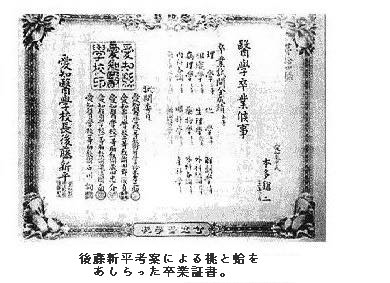 |
The Medical Museum of Nagoya University is located on the fourth floor of the Medical Library. It collects, preserves, and exhibits antique medical books, historical medical instruments, photographs and other items to promote understanding of the history of the Nagoya University School of Medicine in the context of the Tokai district and to look forward to the future of medical science. Parts of the collections can be accessed through the Digital Archive. Registration at the Medical Library counter is required for the actual use of these materials. |
|
6. GOTO Shinpei, President of Aichi Medical School |
|
|
 |
Diploma adorned with peaches and clams, designed by GOTO Shinpei
In May of Meiji year 13 (1880), shortly after RORETZ left, GOTO Shinpei became acting president and, in October of the following year (1881), director and president of the renamed Aichi Hospital and Aichi Medical School. GOTO inherited the policies of former president YOKOI Nobuyuki and decided to eliminate high-paid foreign teachers in favor of hiring Japanese teachers, which meant making a break from "the age of employed foreigners".
Except for a few of the courses in natural science, the school's lineup of teachers and curricula were far above the standards required by the Ordinances of the Ministry of Education in numbers and terms of courses, number of school days, and number of doctors of medicine who had graduated from Tokyo University. The faculty appointed as first-class teachers included graduates of Tokyo University, namely SUZUKI Konosuke, NARASAKA Gen'ichiro, KUMAGAI Konosuke and OGURA Kaiji, among others. The four-year course curriculum RORETZ left behind was updated in Meiji year 14 (1881), following the systematic steps "from general to particular". |
In January of Meiji year 16 (1883), the School smoothly acquired authorization as a first-grade medical school, which was accredited to grant a medical practitioner license to its graduates, owing to the systematic education system established by RORETZ and the recruitment of teachers carried out by GOTO.
On April 6, Meiji year 15 (1882), ITAGAKI Taisuke2 was attacked by a ruffian and injured while he was campaigning in Gifu City. This Gifu incident is known for the famous phrase "ITAGAKI may die, but liberty never will!" Although a telegram requesting a doctor's visit was received by GOTO, Aichi Prefecture did not allow it due to its concern about the government. Upon repeated requests by telegram, a determined GOTO rushed to Gifu in a rickshaw pulled by two men. "You should be proud of this injury, sir!" thundered GOTO at ITAGAKI, and disinfected the wound using Lister's method. It is said that ITAGAKI sensed GOTO's bold determination from his words and actions and regretted that he was not a politician.
2: A Japanese politician and leader of the Freedom and People's Rights Movement
Of all the members of the school and hospital, RORETZ had the highest expectations of GOTO and educated him as if he were his own child. When he was transferred to the Ishikawa Prefectural Hospital, RORETZ intended to take GOTO with him, and GOTO also wished to go. However, because the Aichi Prefectural Government earnestly desired GOTO to stay in Nagoya, RORETZ gave up. The two greatest gifts that GOTO received from RORETZ were an awareness of hygiene administration and a way of thinking derived from Western scientific substantiation - which means collecting data carefully and thoroughly based on a sudden new idea, and establishing a detailed and grand project. GOTO's later life stands on the extension of these two ideas.
Following in the footsteps of RORETZ, GOTO had already submitted a "Proposal towards establishing medical police (sanitary administration)" to the Aichi Prefectural Government in his days as a second-grade hospital doctor. He continued his efforts, proposing an "Outline for the establishment of an office of sanitary police (eisei keisatsu) in Aichi Prefecture" to NAGAYO Sensai, Director of the Sanitary Bureau. He also organized doctors in the prefecture to set up a private sanitation society, "Aishusha". It was also GOTO who began to issue the "Aichi-Ken Koritsu-Byoin Oyobi Igakko Hokoku (Reports on Aichi Prefectural Public Hospital and Medical School)", which led to the current School's journal, "Daigaku Ichiran".
In January, Meiji year 16 (1883), GOTO joined the Home Ministry under Director NAGAYO Sensai and practiced the "concept of public health administration", placing himself within the administration. He entered politics after being assigned as the colony executive of Taiwan and Manchuria. His policies, which were often described as "O-buroshiki" (large cloth wrapper, meaning exaggerative or overambitious) from the extraordinariness of his ideas, were always supported by detailed statistical research and highlighted the significance of infrastructure development based on the concept of public health administration. This is why he is today called the "scientific politician".
|
|
|
|
|